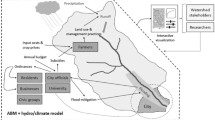Abstract
This paper compares the results of two multisectoral models used to plan the dynamic consistency of sectoral investment. Solution of an optimizing model forecasts a frontier of the economy's future choice set. This frontier represents a ten year welfare gain only 2 or 3 percent greater than any investment program simulated by a dynamic Leontief system. The paper explains what efficient behavior accounts for the “better” performance of the optimizing model. Developing dynamic programming models is costly in terms of data, computational complexity, man-machine interaction, and solution interpretation. Therefore, it is recommended that the lessons derived by working with the dynamic LP be applied to improve the planner's control of the less expensive input/output simulation model.
Similar content being viewed by others
References
Bergendorff, Hans, and Peter B. Clark (1973), “Chile: An Experimental Model for Testing Consumption Redistribution,” Development Research Center, The World Bank.
Blitzer, Charles R., Peter B. Clark and Lance Taylor (1975), Economy-Wide Models and Development Planning, Oxford University Press.
ClarkPeter B., and LanceTaylor (1971), “Dynamics Input-Output Planning With Optimal End Conditions: The case of Chile,” Economics of Planning, 11: 10–30.
Eckaus, Richard S. and Kirit S. Parikh (1968), Planning for Growth: Multi-Sectoral, Intertemporal Models Applied to India, MIT Press.
Taylor, Lance (1971), “Investment Timing in Two-Gap Models,” in H. B. Chenery (ed.), Studies in Development Planning, Harvard University Press.
Taylor, Lance (1975), “Theoretical Foundations and Technical Implications,” in Blitzer, Clark and Taylor (1975).
Additional information
Final Draft for Economics of Planning-April, 1975
H. G. Bergendorff is a staff economist at the Development Research Center of the World Bank, P. B. Clark is Staff Director, Center for Energy Policy (Boston, Mass., U.S.A.) and L. Taylor is Professor of Nutrition Economics at Massachusetts Institute of Technology. The project has been sponsored by the Development Research Center of the World Bank. The authors are grateful for the collaboration of Alejandro Foxley and Paul Ide in early versions of this study and for the assistance of Lucy Cardwell, Jon Eaton, Ruth Sheshinski, and Mieko Nishimizu during the computation phase. Any errors and the interpretations expressed are the responsibility of the authors alone.
Rights and permissions
About this article
Cite this article
Bergendorff, H.G., Clark, P.B. & Taylor, L. Welfare gains from optimization in dynamic planning models. Econ Plann 13, 75–90 (1973). https://doi.org/10.1007/BF00410552
Issue Date:
DOI: https://doi.org/10.1007/BF00410552




